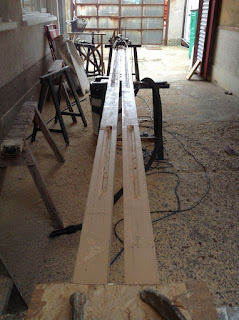21.09.-27.09.15
Working on the yard, boom, mast and rubrail & top-coating the hull
The 4th primer-coat I drysanded with 320 grit continuing with wetsanding 320 and afterwards 400 grit. That result was o.k. then. At Tuesday we started to put on the first of 4 coats of Epifanes Double-Pack Top Coat. One person rolls on the colour, the other one puts off what seems to be to much with a ........
As usually we painted late at night, night after night and always a bit later as the drying time was 24 hours and between each layer of top-coat the paint had to be wetsanded with a 600 grit abrasive and carfully cleaned after to get the surface as dust-free as possible.
While the painting was evening-/night-shift during the day we worked on the yard, boom, mast and the rub rail.
While I finished the yard, Ant & Ross did the scarfs of the mast and glued them. After that Ross started to shape the boom and finished it until the end of the week.
.jpg) |
| Ross, shaping the boom |
Pete did all the work concerning the rub-rail: scarfing, glueing and fitting it to the sheer-plank. The rubrails will be part of the sheerplanks and will be fitted to their bottom edge, were they meet the white top-coat of the hull.
 |
| The two 7.50 m long rubrails |
 |
| Pete´s scarfs are nearly unvisible! Well done! |
 |
| The two masthalfes with one straight and one tapered side |
On Thursday I started to shape the two masthalfes. I got the advice to add 10 inches to the mastlength to be able to hoist the sails properly. The mast will have an asymmetric shape. The bowside will be tapered and the aftside straight.
 |
| The partly hollowed mastpieces |
To reduce the mastweight, I hollowed the 2 masthalfes with a router according the rule 20:60:20 which means 20% of the diameter should be left to get full stability. The first 500 mm I left solid to mount my fittings later.





















